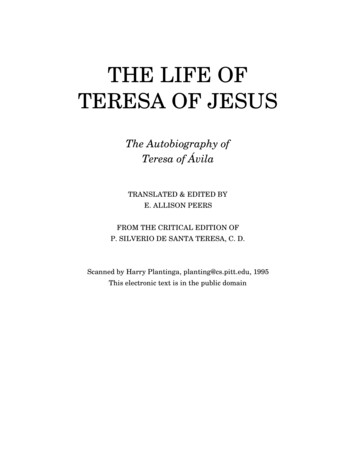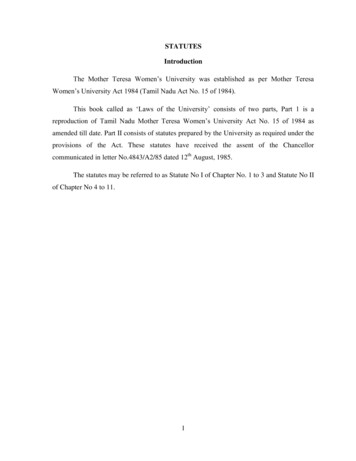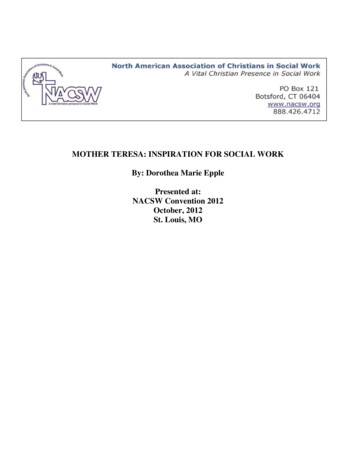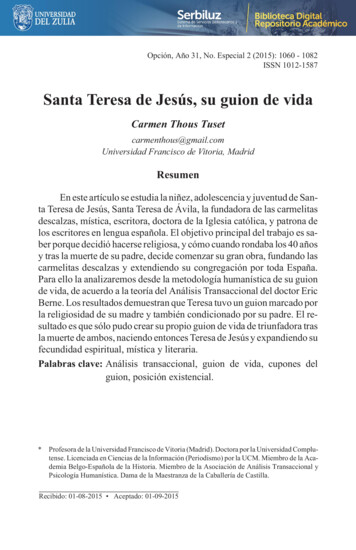
Transcription
THE LIFE OFTERESA OF JESUSThe Autobiography ofTeresa of ÁvilaTRANSLATED & EDITED BYE. ALLISON PEERSFROM THE CRITICAL EDITION OFP. SILVERIO DE SANTA TERESA, C. D.Scanned by Harry Plantinga, planting@cs.pitt.edu, 1995This electronic text is in the public domain
2To the Gracious Memory ofP. EDMUND GURDONSometime Prior of theCarthusian Monastery of MirafloresA man of God
3CONTENTSTRANSLATOR'S PREFACEPRINCIPAL ABBREVIATIONSAN OUTLINE OF THE LIFE OF ST. TERESAGENERAL INTRODUCTION TO THE WORKS OF ST. TERESATHE LIFE OF THE HOLY MOTHER TERESA OF JESUSINTRODUCTIONCHAPTER I. -- Describes how the Lord began to awaken her soul in childhood to a loveof virtue and what a help it is in this respect to have good parentsCHAPTER II. -- Describes how these virtues were gradually lost and how important it isin childhood to associate with people of virtueCHAPTER III. -- Describes how good companionship helped to awaken desires in herand the way in which the Lord began to give her light concerning the delusionunder which she had been sufferingCHAPTER IV. -- Describes how the Lord helped her to force herself to take the habitand tells of the numerous infirmities which His Majesty began to send herCHAPTER V. -- Continues to tell of the grievous infirmities which she suffered and ofthe patience given her by the Lord, and of how He brings good out of evil, as willbe seen from an incident which happened to her in the place where she went fortreatmentCHAPTER VI. -- Describes all that she owed to the Lord for granting her resignation insuch great trials; and how she took the glorious Saint Joseph for her mediatorand advocate; and the great profit that this brought herCHAPTER VII. -- Describes how she began to lose the favours which the Lord hadgranted her and how evil her life be came. Treats of the harm that comes toconvents from laxity in the observance of the rule of enclosureCHAPTER VIII. -- Treats of the great benefit which she derived from not entirely givingup prayer lest she should ruin her soul. Describes the excellence of prayer as ahelp towards regaining what one has lost. Urges all to practise it. Says what greatgain it brings and how great a benefit it is, even for those who may later give itup, to spend some time on a thing which is so goodCHAPTER IX. -- Describes the means by which the Lord began to awaken her soul andto give her light amid such great darkness, and to strengthen the virtues in her sothat she should not offend HimCHAPTER X. -- Begins to describe the favours which the Lord granted her in prayer.Explains what part we ourselves can play here, and how important it is that weshould understand the favours which the Lord is granting us. Asks those to
4whom she is sending this that the remainder of what she writes may be keptsecret, since she has been commanded to describe in great detail the favoursgranted her by the LordCHAPTER XI. -- Gives the reason why we do not learn to love God perfectly in a shorttime. Begins, by means of a comparison, to describe four degrees of prayer,concerning the first of which something is here said. This is most profitable forbeginners and for those who are receiving no consolations in prayerCHAPTER XII. -- Continues to describe this first state. Tells how far, with the help ofGod, we can advance by ourselves and describes the harm that ensues when thespirit attempts to aspire to unusual and supernatural experiences before they arebestowed upon it by the LordCHAPTER XIII. -- Continues to describe this first state and gives counsels for dealingwith certain temptations which the devil is sometimes wont to prepare. Thischapter is very profitableCHAPTER XIV. -- Begins to describe the second degree of prayer, in which the Lordgrants the soul experience of more special consolations. This description is madein order to explain the supernatural character of these consolations. It should bemost carefully notedCHAPTER XV. -- Continues speaking of the same subject and gives certain counsels asto how the soul must behave in this Prayer of Quiet. Tells how there are manysouls who attain to this prayer and few who pass beyond it. The things touchedherein are very necessary and profitableCHAPTER XVI. -- Treats of the third degree of prayer and continues to expound verylofty matters, describing what the soul that reaches this state is able to do and theeffects produced by these great favours of the Lord. This chapter is wellcalculated to uplift the spirit in praises to God and to provide great consolationfor those who reach this stateCHAPTER XVII. -- Continues the same subject, the exposition of this third degree ofprayer. Concludes her exposition of the effects produced by it. Describes thehindrances caused in this state by the imagination and the memoryCHAPTER XVIII. -- Treats of the fourth degree of prayer. Begins to describe in anexcellent way the great dignity conferred by the Lord upon the soul in this state.This chapter is meant for the great encouragement of those who practise prayerto the end that they may strive to reach this lofty state, which it is possible toattain on earth, though not through our merits but by the Lord's goodness. Let itbe read with attention, for its exposition is most subtle and it contains mostnoteworthy thingsCHAPTER XIX. -- Continues the same subject. Begins to describe the effects produced inthe soul by this degree of prayer. Exhorts souls earnestly not to turn back, even ifafter receiving this favour they should fall, and not to give up prayer. Describesthe harm that will ensue if they do not follow this counsel. This chapter is to beread very carefully and will be of great comfort to the weak and to sinnersCHAPTER XX. -- Treats of the difference between union and rapture. Describes thenature of rapture and says something of the blessing that comes to the soul
5which the Lord, of His goodness, brings to it. Describes the effects which itproduces. This chapter is particularly admirableCHAPTER XXI. -- Continues and ends the account of this last degree of prayer.Describes the feelings of the soul in this state on its return to life in the world andthe light which the Lord sheds for it on the world's delusions. Contains gooddoctrineCHAPTER XXII. -- Describes how safe a practice it is for contemplatives not to uplifttheir spirits to lofty things if they are not so uplifted by the Lord, and how thepath leading to the most exalted contemplation must be the Humanity of Christ.Tells of an occasion on which she was herself deceived. This chapter is veryprofitableCHAPTER XXIII. -- Resumes the description of the course of her life and tells how andby what means she began to aim at greater perfection. It is of advantage forpersons who are concerned in the direction of souls that practise prayer to knowhow they must conduct themselves in the early stages. The profit that she herselfgained therebyCHAPTER XXIV. -- Continues the subject already begun. Describes how her soulprofited more and more after she began to obey, how little it availed her to resistthe favours of God and how His Majesty went on giving them to her inincreasing measureCHAPTER XXV. -- Discusses the method and manner in which these locutionsbestowed by God on the soul are apprehended without being heard and alsocertain kinds of deception which may occur here and the way to recognize them.This chapter is most profitable for anyone who finds himself at this stage ofprayer because the exposition is very good and contains much teachingCHAPTER XXVI. -- Continues the same subject. Goes on with the description andexplanation of things which befell her and which rid her of her fears and assuredher that it was the good spirit that was speaking to herCHAPTER XXVII. -- Treats of another way in which the Lord teaches the soul and in anadmirable manner makes His will plain to it without the use of words. Describesa vision and a great favour, not imaginary, granted her by the Lord. This chaptershould be carefully notedCHAPTER XXVIII. -- Treats of the great favours which the Lord bestowed upon her,and of His first appearance to her. Describes the nature of an imaginary vision.Enumerates the important effects and signs which this produces when itproceeds from God. This chapter is very profitable and should be carefully notedCHAPTER XXIX. -- Continues the subject already begun and describes certain greatfavours which the Lord showed her and the things which His Majesty said to herto reassure her and give her answers for those who opposed herCHAPTER XXX. -- Takes up the course of her life again and tells how the Lord grantedher great relief from her trials by bringing her a visit from the holy man, FrayPeter of Alcántara, of the Order of the glorious Saint Francis. Discusses the severetemptations and interior trials which she sometimes suffered
6CHAPTER XXXI. -- Treats of certain outward temptations and representations made toher by the devil and of tortures which he caused her. Discusses likewise severalmatters which are extremely useful for people to know if they are walking on theroad to perfectionCHAPTER XXXII. -- Tells how the Lord was pleased to carry her in spirit to a place inhell which she had merited for her sins. Describes a part of what was shown herthere. Begins to tell of the way and means whereby the convent of Saint Josephwas founded in the place where it now isCHAPTER XXXIII. -- Proceeds with the same subject -- the foundation of the convent ofthe glorious Saint Joseph. Tells how she was commanded not to continue it, howfor a time she gave it up, how she suffered various trials and how in all of themshe was comforted by the LordCHAPTER XXXIV. -- Describes how about this time she had to leave the place, for areason which is given, and how her superior ordered her to go and comfort agreat lady who was in sore distress. Begins the description of what happened toher there, of how the Lord granted her the great favour of being the meanswhereby His Majesty aroused a great person to serve Him in real earnest and ofhow later she obtained help and protection from Him. This chapter should becarefully notedCHAPTER XXXV. -- Continues the same subject -- the foundation of this house of ourglorious father Saint Joseph. Tells how the Lord brought it about that holypoverty should be observed there and why she left that lady, and describesseveral other things that happened to herCHAPTER XXXVI. -- Continues the subject already begun and describes the completionof the foundation of this convent of the glorious Saint Joseph, and the greatopposition and numerous persecutions which the nuns had to endure aftertaking the habit, and the great trials and temptations which she suffered, andhow the Lord delivered her from everything victoriously, to His glory and praiseCHAPTER XXXVII. -- Describes the effects produced upon her after the Lord hadgranted her any favour. Adds much sound teaching. Says how we must strive inorder to attain one degree more of glory and esteem it highly and how for notrial must we renounce blessings which are everlastingCHAPTER XXXVIII. -- Describes certain great favours which the Lord bestowed uponher, both in showing her certain heavenly secrets and in granting her other greatvisions and revelations which His Majesty was pleased that she shouldexperience. Speaks of the effects which these produced upon her and of the greatprofit which they brought to her soulCHAPTER XXXIX. -- Continues the same subject and tells of the great favours which theLord has shown her. Describes His promises to her on behalf of persons forwhom she might pray to Him. Tells of some outstanding respects in which HisMajesty has granted her this favourCHAPTER XL. -- Continues the same subject and tells of the great favours which theLord has granted her. From some of these may be obtained most excellentteaching, and, next to obedience, her principal motive in writing has been, as shehas said, to convey this instruction and to describes such favours as are for the
7profit of souls. With this chapter the narrative of her life which she has writtencomes to an end. May it be to the glory of the Lord. AmenLetter written by the Saint to Father García de Toledo when sending him her Life
8TRANSLATOR'S PREFACEIFor some time after completing my translation of the Complete Works of St. John ofthe Cross, in the year 1935, I had no thought of preparing a similar edition of theworks of that other great Carmelite, to whom he owed so much, St. Teresa. Evenwhen the welcome given to the works of el Santo in their new dress showed what anunexpectedly and encouragingly large public there now was for this type ofliterature, it seemed to me that la Santa was on the whole sufficiently well servedby the translations already in existence. But many readers of St. John of the Crosswere not of this opinion: not all St. Teresa's works, they said, had been satisfactorilytranslated; not all of them, even, were based on an up-to-date Spanish text; and, inany case, there was ample room for a fresh, modern version of the Complete Works,made by a single hand, with footnotes of an elucidatory rather than a piouslydiscursive type -- an edition, furthermore, which would facilitate individual study byproviding comprehensive indices.As time went on, this point of view was increasingly pressed upon me, and by agreat variety of people. In Spain, a well-known Academician asked me when acomplete St. Teresa was to appear in English; in the American Southwest, a remotecommunity of Carmelite nuns whom I visited put the same question; in England,the remark became almost a commonplace. At last I began to reconsider theposition. The only easily accessible versions of the Life and the Foundations werestill, though they had been several times revised, essentially the versions made byDavid Lewis in 1870-1: as regards both language and interpretation they couldcertainly be greatly bettered. The Stanbrook Benedictines' translation of theInterior Castle, the Way of perfection and the Minor Works (in prose and verse)dated from the beginning of this century and were much superior to Lewis; yet sincethese volumes had first appeared P. Silverio de Santa Teresa had published hiscomprehensive and critical Spanish edition of the Complete Works, which wouldmake it possible to add a good deal, especially in the Way of perfection, to what wasalready available. The most recently published translation was that made by theBenedictines of Stanbrook of the Letters (4 vols., 1919-24). This excellent piece ofwork was unfortunately completed before P. Silverio's three-volume edition of theLetters appeared, and, though in 1927 its editors brought out an appendix to theirfinal volume consisting of twenty two letters and some fragments to which they hadnot previously had access, there is a good deal in P. Silverio's three volumes which itwould be worth while to pass on to the English reader. None the less, the Letterspresented the least urgent part of the problem.After full consideration, I decided to undertake an edition of the Complete Works,publishing them all, in one series, as soon as might be, with the exception of theLetters, a new edition of which it seemed better to postpone for the present, since itwould be strange if the recent years of upheaval in Spain did not lead to freshdiscoveries. Accordingly, the work was begun in the summer of 1939, continuedthroughout the whole period of the War and is only now completed.
9IIIt might be thought that St. Teresa -- so often colloquial and matter-of-fact in herlanguage -- would be a great deal easier to translate than St. John of the Cross, butthe truth is very nearly the exact opposite. There are certainly passages andphrases in St. John of the Cross which present the greatest difficulty, but they arerelatively few: for all the sublimity of his teaching, his expression is, as a rule,crystal-clear, and at every turn the translator is assisted by his logical and orderlymind and by his great objectivity. Much of St. Teresa's work, on the other hand, isautobiographical narrative, and, even in that part of it which is not, every pagebears the indelible impress of her forceful and vivid personality. In addition to thedifficulty of interpreting that personality by means of a translation there arestylistic difficulties of a kind presented by few, if any, other Spanish writers of thefirst rank. As an appreciation of these two points will help us to a fullerunderstanding of the qualities of the work of St. Teresa, it will be worth our while toconsider them in greater detail.1. To Spaniards there is no writer whose personality communicates itself withgreater immediacy and intensity than does that of St. Teresa -- and this bothbecause of her almost complete disregard of the literary conventions and because innothing that she wrote could her strong individuality ever be concealed. Notranslator could hope to convey that impression as fully and forcibly as do theoriginal words, but he is not therefore exempted from the obligation to convey asmuch of it as possible. In an attempt to do this I have denied to her vigorous andpugnacious phrases the superfluous words in which another age might have clothedthem. In such passages as these we can hear the authentic and virile note of a saintunlike any to be found in a stained-glass window:"Rest, indeed!" I would say. "I need no rest; what I need is crosses."1*We can make use only of a single cell -- what do we gain by its beingvery large and well built? What, indeed? We have not to spend all ourtime looking at the walls.2"Oh, the devil, the devil!" we say, when we might be saying "God! God!"and making the devil tremble. Of course we might, for we know hecannot move a finger unless the Lord permits it. Whatever are wethinking of? I am quite sure I am more afraid of people who arethemselves terrified of the devil than I am of the devil himself.3If Thou wilt (prove me) by means of trials, give me strength and letthem come.4In rendering these and similar phrases I have had always in my mind the Teresawhom I have come to know through close contact with her over many years. Awoman who made her decisions and then stuck to them regardless of theconsequences:1Life, Chap. XIII (p. 140).* Special Note: The references for the works of St. Teresa (except for Life) used in the footnotesthroughout this work refer to Complete Works of St. Teresa, translated and edited by E. AllisonPeers, 3 vols., Sheed & Ward, New York, 1957.2Foundations, Chap. XIV (Vol. III, p. 66).3Life, Chap. XXV (p. 243).4Way of perfection, Chap. XXXII (Vol. II, p. 138).
10I was well aware that there was ample trouble in store for me, but, asthe thing was now done, I cared very little about that.5Who, if she ever thought she was afraid of the Inquisition, would "go and pay it avisit of (her) own accord."6 And who counselled her nuns to be like herself:Strive like strong men until you die in the attempt, for you are here fornothing else than to strive.7Again, St. Teresa has continual outbursts of sanctified commonsense, humour andirony. "I just laughed to myself" is a type of phrase which we continually meet in herwork and she has left us an excellent specimen of her sustained laughter in the"Judgment . . . upon various writings". 8 She particularly disliked pretentiousness,even in what was good, and castigated it with those most effective weapons. Eveninto that sublime commentary on the Song of Songs entitled the Conceptions of theLove of God, creeps a delightfully shrewd description of the lady whose selfimportance was so intimately mingled with her devoutness. She, and others likeher,were saints in their own opinion, but, when I got to know them, theyfrightened me more than all the sinners I have ever met.9Some of her stories are shot through and through with an allusive humour which itneeds all one's ingenuity to render -- such are the accounts of her visit to Duruelo,with Fray Antonio sweeping out the porch and the depression caused in thebusiness men who came with her from Medina by all those crosses and skulls10; herefforts to address a great lady as befitted her rank and how she "got it wrong'';11poor María del Sacramento and her attack of nerves on All Souls' eve in the sparselyfurnished convent at Salamanca12; the group of devout ladies at Villanueva, onlyone of whom could read with any ease, who tried to recite their Office usingdifferent versions of the Breviary: "God will have accepted their intention andlabour, but they can have said very little that was correct."13 No less apt to evadeone are innumerable little natural touches which, in the English, if carelesslyrendered, might easily pass unnoticed:I was . . . ashamed to go to my confessor . . . for fear he might laugh atme and say: "What a Saint Paul she is, with her heavenly visions!Quite a Saint Jerome!"14Blessed be Thou, Lord, Who hast made me so incompetent andunprofitable!155Life, Chap. XXXVI (pp. 344-5).6Life, Chap. XXXIII (p. 312).7Way of perfection, Chap. XX (Vol. II, p. 86).8Vol. III, pp. 229-31.9Conceptions of the Love of God, Chap. II (Vol. II, p. 375).10Foundations, Chap. XIV (Vol. III, p. 66).11Way of perfection, Chap. XXII (Vol. II, p. 94).12Foundations, Chap. XIX (Vol. III, p. 94).13Foundations, Chap. XXVIII (Vol. III, p. 164).14Life, Chap. XXXVIII (p. 361).15Life, Chap. XIII (p. 147).
11I only wish I could write with both hands, so as not to forget one thingwhile I am saying another.16From foolish devotions may God deliver us. 17And in her less frequent ironical passages, such as the description in the Way ofperfection of how the devil invents "laws by which we (nuns) go up and down inrank, as people do in the world",18 or the animadversions in the Life upon theniceties of worldly etiquette:-- the title "Illustrious" has to be given to a man who formerly was noteven described as "Magnificent".19The style here is so sedate that one has to pause for quite a long time beforepressing the button lest the photograph should fail to catch the twinkle in the eye.Then there are the thousand touches which reveal the temperamentally greatwriter who never became, or wanted to become, a professional one -- the geniusborn, not made. This trait in herself St. Teresa never allows us to forget -- which isjust as well for the translator who might otherwise conventionalize her. She is"stupid", "incompetent" and always busy with really "important" things like herspinning-wheel. She has "no learning", suffers from "noises" in the head, a badmemory, and a "rough" and "heavy" style. It is useless for her to write anything onmystical theology, for -- "I am unable to use the proper terms". She cannot preventherself from digressing if she feels like it: otherwise, her writing "worries" her.20"How I do let myself wander!" begins Chapter XXIII of the Way of perfection.21 Asfor the dates she quotes -- "you must always understand (them) to be approximate -they are of no great importance."22 And she scribbles at breakneck speed and withtremendous intensity, never revising her work -- nor even rereading it to see whatshe has said last.23 All the time the translator has to remember that he is dealingwith this unique kind of woman -- it would be nothing short of a tragedy if heturned her into a writer of text-books.2. The second type of difficulty which should be referred to will perhaps be ofgreater interest to the student than to the general reader. In her "rough style", shesays comfortingly at the end of Chapter XVI of the Way of perfection, her argumentwill be better understood "than in other books which put it more elegantly."24 Thatno doubt was true, and may still be true, so far as the general trend of the argumentis concerned -- and one has constantly to be on one's guard, when there is some"elegant" word that exactly expresses her meaning, against using it -- but itcertainly does not apply to the exact sense of particular passages. Even Spaniardsfamiliar with her books are continually baffled when asked the precise meaning ofphrases which at first sight may seem perfectly simple. Vivid, disjointed, elliptical,paradoxical and gaily ungrammatical, the nun of Ávila continually confounds the16Way of perfection, Chap. XX (Vol. II, p. 88).17Life, Chap. XIII (p. 145).18Ibid., Chap. XXXVI (Vol. II, p. 156).19Life, Chap. XXXVII (p. 360).20Such references as these are to be found everywhere. See, for example, p. 151, Vol. II, pp. 68, 234,291, Vol. III, pp. xxii, xxiii.21In the Escorial manuscript. See Vol. II, p. 97, n. 6.22Foundations, Chap. XXV (Vol. III, p. 132 ).23Way of perfection, Chap. XIX (Vol. II, p. 76).24Vol. II, p. 68.
12successors of those "learned men," to whom in her life she turned so often forenlightenment. One often has frankly to guess at her exact meaning, and half adozen people may make half a dozen different guesses, none of which anybody canpick out as definitely correct.To illustrate these characteristics of her style, I have, for the sake of brevity,selected examples in which her meaning is fairly evident. When to the difficulty ofrendering her words without paraphrasing them is added that of deciding betweenseveral possible meanings it can be imagined how much the task is magnified.In the course of a discussion on melancholy in nuns, in the seventh chapter of theFoundations, St. Teresa observes that lack of discipline is often more to blame thantemperament:Digo en algunas, porque he visto, que cuando hay a quien temer, se vana la mano y pueden.(Lit.: I mean in some, for I have seen that, when there is whom to fear,they become docile and can.)This, in English, has to be expanded somewhat as follows:I know it is so in some; for, when they have been brought before aperson they are afraid of, I have seen them become docile, so I knowthat they can.25Again, in the Interior Castle (VI, viii), she has been considering how a person can besure whether some vision is of Christ or of a saint:Aun ya el Señor, cuando habla, más fácil parece; mas el santo que nohabla, sino que parece le pone el Señor allí por ayuda de aquel alma ypor compañía, es más de maravilla.(Lit.: Even now the Lord, when He speaks, [it] seems easier; but thesaint who speaks not, but seems to have been placed there by the Lordfor aid to that soul and for company, is more remarkable.)Which means:When it is the Lord, and He speaks, it is natural that He should beeasily recognized; but even when it is a saint, and no words are spoken,the soul is able to feel that the Lord is sending him to be a help and acompanion to it; and this is (still) more remarkable.26Then there are shorter phrases, couched in a staccato, almost telegraphic style,hard enough to translate without a weakening of their generally considerable force-Con esto, mal dormir, todo trabajo, todo cruz!(Lit.: With this, bad sleep, all trial, all cross!)And then, the scant sleep they get: nothing but trials, nothing butcrosses!27 --25Vol. III, p. 39.26Vol. II, p. 312.27Life, Chap. XIII (p. 147).
13but quite devastating when the clipt phraseology makes one doubtful of themeaning. And there are words which St. Teresa uses in a sense entirely her own,and conjunctions which do not in the least mean what they say -- e.g., "and" for"but", and vice versa, not to mention the conjunction que, which can stand foralmost any other.One has also to watch for, and preserve, the Saint's colloquialisms. Even in talkingwith God, she tells us, she has a "silly way"in which I often speak to Him without meaning what I am saying; for itis love that speaks, and my soul is so far transported that I take nonotice of the distance that separates it from God.28How much more unconventional, then, is she likely to be with her readers! Not onlyin her modes of address, but in the introduction of everyday, semi-proverbialphrases, some of which are no longer in use in Spain and might be unintelligible didshe not thoughtfully accompany them with an "as one might put it" or "as they say".It would not be hard to turn into current English slang such phrases as:They see that these things are considered, as one might say, "allright". 29(I am) so peevish and ill tempered that I seem to want to snapeveryone up.30We had not so much as a scrap of brushwood to broil a sardine on.31So with her homely and vivid metaphors: the Christian making progress "at a hen'space" or even "like hens with their feet tied"; his adversary the devil "clapping hishands to his head" in despair of ever vanquishing him; love finding an outlet andnot being "allowed to boil right over like a pot to which fuel has been appliedindiscriminately";32 worldly aids to devotion being of no more use to lean upon than"dry rosemary twigs" which break at the slightest pressure.33 All these -- and thereare hundreds of them enlivening her narratives and illumining her expositions -can be so easily spoiled in translation.Another stumbling block is repetition, a practice to which St. Teresa was greatlyaddicted. Some of her repetitions of words are merely careless and clumsy -- as inher constant use of the word "great"34 -- and these I have been content to indicaterather than reproduce every time they occur. When she repeats phrases it isgenerally for emphasis -Oh, what terrible harm, what terrible harm is wrought . . . when thereligious life is not properly observed!35and, except occasionally where our language necessitates another formula for theconveying of the effect, her phraseology can as a rule be reproduced as it stands. Butoften the same word is repeated in a different sense, sometimes so pointedly that it28Life, Chap. XXXIV (p. 324).29Life, Chap. VII (p. 98 ).30Life, Chap. XXX (p. 282 ).31Foundations, Chap. XV (Vol. III, p. 74).32Life, Chaps. XIII, XXXVII, XXVI, XXIX (p. 140, 380, 244, 273).33Relations, III (Vol. I, p. 316).34See, for a typical example, Life, Chap. XXXVIII (p. 362).35Life, Chap. VII (p. 98).
14produces an obvious play upon the word's two or more meanings. Some of theseusages cannot be conveyed in En
AN OUTLINE OF THE LIFE OF ST. TERESA GENERAL INTRODUCTION TO THE WORKS OF ST. TERESA THE LIFE OF THE HOLY MOTHER TERESA OF JESUS INTRODUCTION CHAPTER I. -- Describes how the Lord began to awaken her soul in childhood to a love of virtue and what a he










